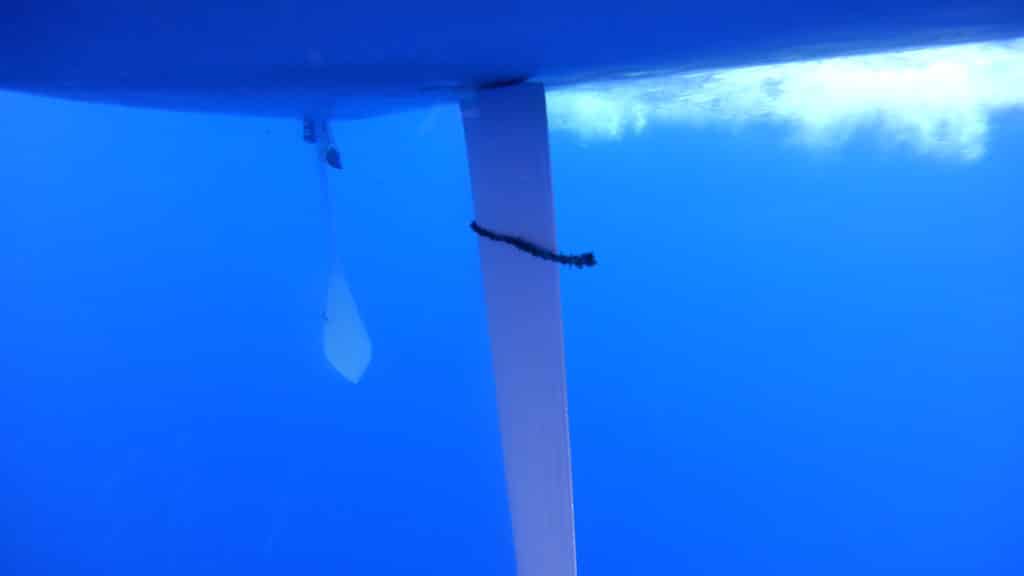
You’ve been going upwind in a really consistent wind and sea state, and the helmsman and trimmers have been hearing, “Same Speed, Same height” for some time now. But halfway up the final beat that changes. It’s now, “Same Speed, lower.” Wind, sail trim, steering—nothing has changed. In that situation, my first priority is to check the keel and rudder. Anything on the blades, such as kelp or plastic bags, disrupts water flow and causes leeway. When that happens, the helm usually starts sailing bow down to keep the speed up, which results in “Same speed, lower.” How do you best prevent catching debris, and when you do, how can you best free the boat from it?
Communication
Keep it simple. You only need to know whether to make a small or large course correction, or simply hold your course. This is all you need:
“Up one for debris.”
“Up 5 for debris.”
“Hold for debris.”
“Down 1 for debris.”
“Down 5 for debris.”
A good bowman can also quickly evaluate our position, our short term goal, or relatives to other boats to determine if it’s better to steer up or down to stay clear, and figure that into the call.
Confirmation
Given that it’s impossible to keep the blades clear 100% of the time, what do you do if you think you’ve picked up something? Many boats have small glass prisms installed in the hull just in front of the keel and rudder so someone can go down below and look through windows. Other boats use oscilloscopes that can be inserted through a small waterproof valve. There is generally one valve by the keel and one by the rudder. You can also rotate it to check the sail drive or prop shaft.
On smaller boats, have crewmember lay down on the deck, getting as low as possible so as to see as high on the blades that they can. Most debris is on the surface, so it’s important to get a view all the way up to the hull.
Removing Debris
Once you’ve confirmed that you have debris on the keel, how can you best remove it? If you have a kelp cutter on the keel, it’s simple. Some bigger boats not only have cutters on the keels and rudders, but also on the sail drives. But how you remove it is important. Always clear the keel first, as anything you remove there can drift aft and get caught on the rudder. Once you clear the keel, count to 5 to give the debris time to completely clear the boat and then clear the rudder.
If you don’t have a kelp cutter, a large, curved, carbon kelp stick works really well. The curve mimics the hull shape allowing the outboard end to get up high on the blades. On most boats you can get to the top of the rudder and keel without laying down. Just be careful with them at higher speeds, as it’s pretty easy to break them.
A floss line works well on keels with slanted leading edges, such as CF27s, J-35s, and Santa Cruz 50s. This is a line that you throw over the bow and, as it hits the keel, it swipes down the leading edge, hopefully carrying the kelp with it. I make a custom floss line out of a fat 1”-1.5” rope that is around 1.5 boat lengths long. I remove the core out so it lays flat as it travels down the keel. I sew fishing weights in one end and splice a loop in the other. I also tie granny knots every 4 feet. These help grab the debris and pull it off. If the debris is up high, I throw the loop end around the bow and hold the weighted end. If the debris is down low, I throw the weighted end around the bow and then run aft with the loop end. If there is a large blob of debris at the top of the keel, I hand an end to a crew member and take the other end around the bow and back to the keel of the other side. From here we “saw” back and forth until the debris is gone.
The Next Generation:
I’ve done every Transpac since 2001, as well as a pair of Pacific Cup races, and I can say with confidence that the issue with trash and debris in the waters we love so much is becoming a bigger problem every year. Boats had to stop and back down on a daily basis. In fact, I was approached recently by an owner who asked if he needed a kelp cutter for the Transpac. My response was that, these days, you need a plastic cutter. I sailed last year’s Transpac in the double-handed division aboard a J-125, and we caught large amounts of plastic a half dozen times. Our kelp cutter just wouldn’t cut through it. The only option was to back down, which is not always an easy maneuver, especially sailing double-handed. Do your part. Recycle, Reuse, pick up, use minimal plastics, and for the of the next generation, support organizations, such as The Rozalia Project, which are working to fight trash in our waters.









